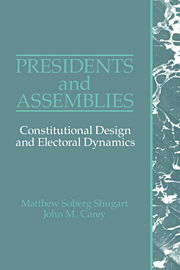Book contents
- Frontmatter
- Contents
- List of tables and figures
- Acknowledgments
- 1 Basic choices in democratic regime types
- 2 Defining regimes with elected presidents
- 3 Criticisms of presidentialism and responses
- 4 The premier-presidential and president-parliamentary experiences
- 5 The constitutional origins of chief executives
- 6 Constitutional limits on separate origin and survival
- 7 Legislative powers of presidents
- 8 Assessing the powers of the presidency
- 9 Electoral dynamics: efficiency and inefficiency
- 10 Electoral rules and the party system
- 11 Electoral cycles and the party system
- 12 Electoral cycles and compatibility between president and assembly
- 13 Conclusions
- Appendix A Electoral rules for one-seat districts and coalition-building incentives
- Appendix B Theoretical explanation for models predicting number of parties in presidential systems
- Bibliography
- Index
5 - The constitutional origins of chief executives
Published online by Cambridge University Press: 05 June 2012
- Frontmatter
- Contents
- List of tables and figures
- Acknowledgments
- 1 Basic choices in democratic regime types
- 2 Defining regimes with elected presidents
- 3 Criticisms of presidentialism and responses
- 4 The premier-presidential and president-parliamentary experiences
- 5 The constitutional origins of chief executives
- 6 Constitutional limits on separate origin and survival
- 7 Legislative powers of presidents
- 8 Assessing the powers of the presidency
- 9 Electoral dynamics: efficiency and inefficiency
- 10 Electoral rules and the party system
- 11 Electoral cycles and the party system
- 12 Electoral cycles and compatibility between president and assembly
- 13 Conclusions
- Appendix A Electoral rules for one-seat districts and coalition-building incentives
- Appendix B Theoretical explanation for models predicting number of parties in presidential systems
- Bibliography
- Index
Summary
INTRODUCTION
As defined in Chapter 2, a principal aspect in which presidential regimes are distinct from parliamentary, premier-presidential, and various hybrid regime types is in the separate origin and survival of executive and assembly. Recall that a requirement for presidentialism is that the chief executive be elected by popular vote. However, in a number of regimes that have generally been considered presidential or hybrid systems, the chief executive has been constituted according to various means, which sometimes modify and sometimes preclude the criterion of popular election. In this chapter, we shall examine in detail various means of constituting chief executive power in presidential and hybrid systems, reviewing a number of case studies to illustrate the possible variations. We undertake this exercise for two main reasons. First, we demonstrate that there are any number of ways to constitute executive power in regimes that are neither presidential nor premier-presidential, nor parliamentary. Second, and more important, the cases highlight the impact that various rules guiding the origin of the executive have on the incentives that drive political behavior. As we shall see, the nature of the party system and of coalition building, as well as the means of replacing the chief executive, all depend largely on the constitutional means by which the executive originates.
- Type
- Chapter
- Information
- Presidents and AssembliesConstitutional Design and Electoral Dynamics, pp. 76 - 105Publisher: Cambridge University PressPrint publication year: 1992
- 1
- Cited by



